We occasionally link to goods offered by vendors to help the reader find relevant products. Some of these may be affiliate based, meaning we earn small commissions (at no additional cost to you) if items are purchased. Here is more about what we do.
A good roasting pan is a valuable investment, and an essential piece of kitchenware for those who love cooking.
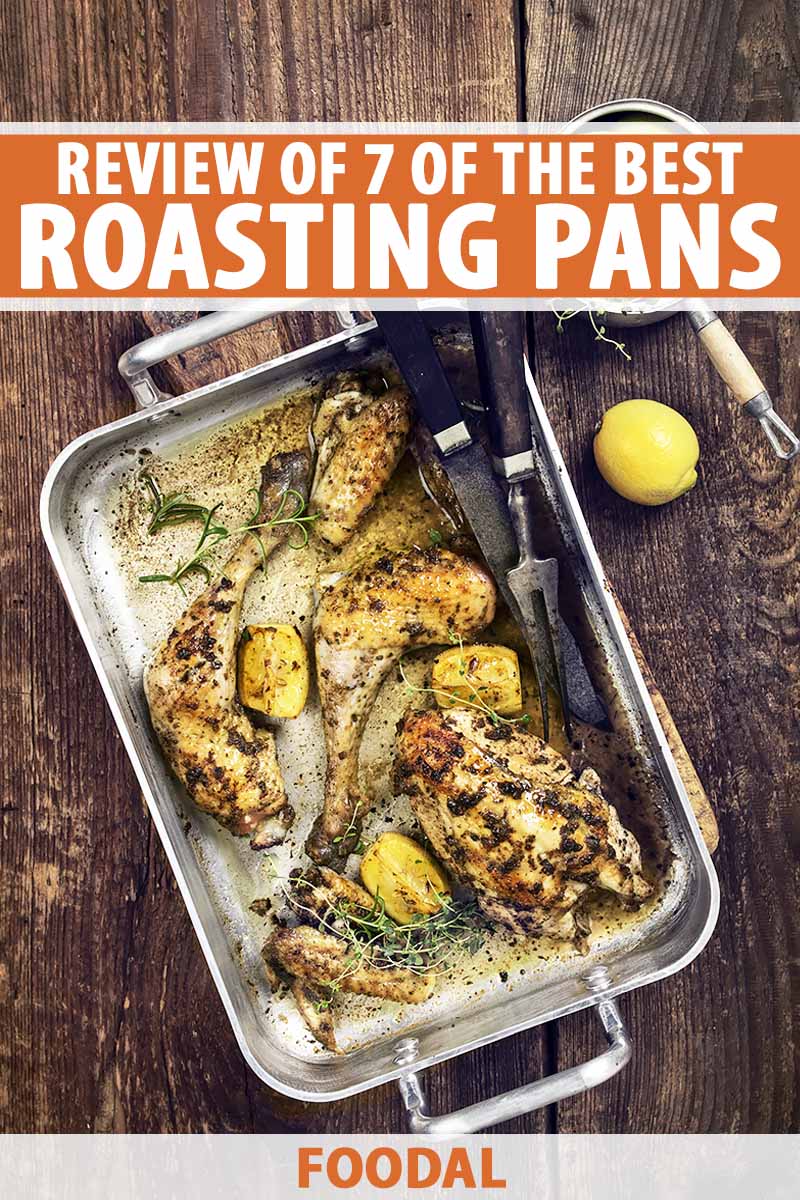
When hosting dinner parties, they’re indispensable for cooking large cuts of meat like ham, whole poultry, and prime rib.
They’re the ideal vessel to cook a variety of veggies, or convenient one-dish meals. And many can also be used in summer for smoking large quantities of meat on the grill.
A good-quality roaster needs to be strong and sturdy, able to distribute heat evenly, and versatile enough to transfer from the oven to the stovetop for deglazing or sauce making, without any hot spots or buckling over direct heat.
Depending on your cooking style, you’ll want to consider some common factors like the types of material used, pan shape, and size.
So, get comfy, sit back, and relax while we serve up the details on how to choose the best roasting pan!
Here’s what’s ahead.
7 of the Best Roasting Pans: A Roaster for Every Cook
- All-Clad HA1 Nonstick
- Bayou Classic Cast Iron
- Cuisinart Chef’s Classic
- Demeyere 5-Ply
- Le Creuset Signature Enameled Cast Iron
- Made-In Blue Carbon Steel
- Viking 3-Ply
7 of the Best Roasting Pans: A Roaster for Every Cook
The following selection of our top picks includes a variety of materials with popular features to suit different cooking styles, and all are induction cooktop compatible.
1. All-Clad HA1 Nonstick
Built from corrosion-resistant and non-reactive hard anodized aluminum for durability and strength, the All-Clad HA1 Nonstick Roasting Pan is finished with a triple layer of PFOA-free, nonstick silicone for effortless food release.
All-Clad HA1 Nonstick Roasting Pan with Rack, available from Sur La Table
The flat aluminum bottom conducts and distributes heat beautifully, and rounded corners with a thick nonstick coating make deglazing fast and easy.
Tall, straight sides reduce splatters and roomy, upright stainless steel handles are securely riveted to the sidewalls for a space-saving grip.
The elevated, nonstick rack permits better airflow for complete heat distribution and even browning. Loop handles make for easy handling and a nonstick coating makes cleanup fast and simple.
The pan has dimensions of 16 by 13 by 5.5 inches. It can hold up to a 25-pound bird, perfect for larger Thanksgiving feasts.
Oven safe to 500°F and dishwasher safe, but hand washing is recommended. Made in China, it comes with All-Clad’s lifetime warranty.
Check prices and read customer reviews on Sur La Table now.
2. Bayou Classic Cast Iron
For outstanding durability, heat retention, and a beautiful sear, the cast iron Bayou Classic is a heavyweight contender.
Bayou Classic Cast Iron Pan, available on Wayfair
The large, oval shape is ideal for roasting large proteins and the high walls give it versatility for savory slow-cooked dishes like chili, gumbo, and stews. Wide molded helper handles have a ridged top for a secure, comfortable purchase.
The thick, flat bottom makes for easy deglazing or whisking, and with repeated use, cast iron forms its own patina for nonstick performance.
A well-fitted, domed lid retains heat and moisture and has a large cast iron loop handle anchored with stainless steel screws.
The Bayou Classic measures 4.75 by 18 by 11.25 inches without the lid, and 9 inches deep with it. It weighs 25 pounds and has a maximum oven temperature of 700°F.
Season before use, avoid acidic ingredients, and hand wash only to preserve the nonstick patina. Made in Turkey, it comes with a one-year limited warranty.
Find customer reviews and prices at Wayfair.
3. Cuisinart Chef’s Classic
A smart and economical option, the 16-inch Cuisinart Chef’s Classic is beautifully crafted of triple ply stainless steel.
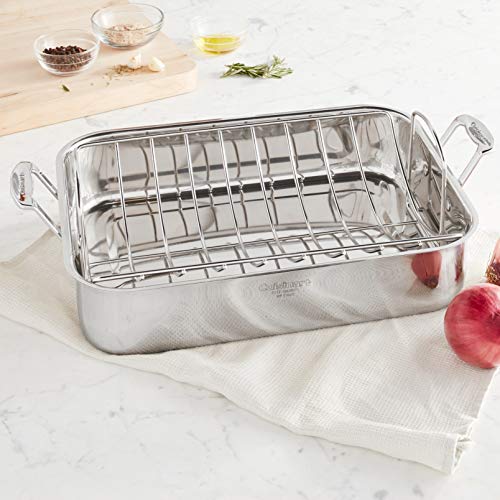
Cuisinart Chef’s Classic Roasting Pan, available on Amazon
The thick base results in professional performance with fast and even heating and perfectly cooked, delicious foods.
With a sleek, mirrored finish, the solid, flat bottom easily transfers to the stovetop for smooth deglazing or whisking without hot spots. And a flared lip gives clean, dripless pouring.
Wide, easy-grip stainless steel handles give a comfortable, firm grip with mitts and are securely riveted to the sidewalls.
The curved, solid stainless steel rack is made of thick-gauge ribs and floats over the bottom, allowing ample air circulation to cook meats evenly throughout. Upright pull handles give easy access and a comfortable grip.
Not including the handles, the pan is 16.8 inches in length, 12.8 inches in width, and 3.4 inches in height. Including the handles and rack insert, everything together measures 21.1 inches in length, 12.8 inches in width, and 5.8 inches in height.
With the rack, the pan weighs a total of 6 pounds. Oven safe to 500°F.
The Cuisinart Chef’s Classic is dishwasher safe, but hand washing is recommended. Made in China, it comes with a limited lifetime warranty.
Attractive and sturdy, the Chef’s Classic elevates stainless steel’s performance to the next level. Prices and customer comments can be found on Amazon.
4. Demeyere 5-Ply Stainless Steel
For high-end performance, the 15.75-inch Demeyere roaster is fully clad in five layers of aluminum and 18/10 stainless steel, including a thick aluminum core, and delivers superior thermal conduction, heat retention, and even distribution throughout.
Demeyere 5-Play Stainless Steel Roasting Pan, available on Zwilling
The five layers provide durability and strength for a flat base that’s engineered to prevent hot spots and warping.
Upright handles are welded to the sidewalls for rugged strength and they’re designed for ergonomic comfort, with a wide, secure grip and a pebbly, bead-blasted finish.
A flared rim provides for dripless pouring and the surface is finished with an electrochemical treatment to protect against discoloration.
The included heavy-gauge rack has upright loop hands and holds up to 15 pounds. Treated with a nonstick coating, cleanup is fast and easy.
The Demeyere 5-Ply measures 2 by 18.25 by 2.75 inches including the handles and weighs just under 9 pounds. Made in Belgium, it comes with a limited lifetime warranty.
Find prices and customer reviews at Zwilling as well as Sur La Table.
5. Le Creuset Signature Enameled Cast Iron
Le Creuset’s 16-inch Signature enameled cast iron roaster offers the outstanding heat retention of cast iron with a non-reactive porcelain coating that improves heat distribution. It is semi-nonstick, and easy to clean.
Le Creuset Signature Enameled Cast Iron Roasting Pan, available at Le Creuset
The Signature line has been engineered with some subtly enhanced features, like enamel with improved resistance to thermal shock that resists chipping, cracking, staining, and daily wear and tear.
And the wide helper handles are 45 percent larger than those of the Classic series to allow easy lifting and a sure, comfortable grip with bulky mitts.
The pan measures 3.5 by 17.5 by 11.5 inches including the handles and weighs 10.7 pounds.
Oven safe to 500°F, this Signature series pan is also dishwasher safe.
Made in France, Le Creuset provides a limited lifetime warranty.
Available in 10 colors, you can find prices and customer reviews at Le Creuset.
6. Made In Carbon Steel
For the purist who needs a savory sear on meats or golden-crusted veggies, Made In’s robust, 15-inch blue carbon steel pan handles scorching heat with outstanding thermal conduction.
Made In Carbon Steel Roasting Pan, available at Made In
Able to withstand scorching temperatures without damage, blue carbon is highly responsive to temperature changes and distributes heat quickly and evenly, making it the ideal material for a perfect sear before going into the oven.
And with repeated use, carbon steel creates its own nonstick coating that cleanly releases foods from the surface.
The flat bottom and curved edges are designed for fast deglazing and easy stirring.
Wide stainless steel handles give a comfy, secure purchase and are firmly fastened to the sidewalls with robust rivets.
And a floating stainless steel rack lifts food off the bottom for full air circulation and even cooking.
Measurements are 2.5 by 18 by 10 inches with the handles. The pan weighs 5.6 pounds and is oven safe to a whopping 1200°F.
Season before use (detailed instructions are included), avoid acidic ingredients, and hand wash only.
Made in France, it comes with Made In’s limited lifetime warranty.
Lively and rugged, the Made In blue carbon roaster delivers professional performance for the home cook. Read customer reviews and find prices at Made In.
7. Viking 3-Ply
For the best overall performance with beautiful, consistent results, the Viking 16-inch, 3-ply roaster boasts top-notch construction with a sleek, polished finish that’s durable and built to last.
Viking 3-Ply Roasting Pan, available at Wayfair
Tri-ply construction is used throughout the bottom and walls to provide excellent thermal conductivity, even heat distribution, durability, and a lustrous exterior. And a unique space-saving design gives safe and easy lifting plus oven-size versatility.
The thick, high-grade metals give warp-resistant strength to support a flat bottom, and with rounded corners and fast, even heating, deglazing or whisking on the stovetop is easy and efficient. Plus, the flared pouring lip makes transferring liquids clean and dripless.
The wide and sturdy loop handles are inverted over the cooking area to save space in the oven and are also designed for easier lifting – and they reduce the storage footprint of this roaster as well. The roomy, one-piece handle and plate base are securely riveted to the sidewalls and give ample room for a sure grip.
Also included is a well-designed nonstick rack that holds up to 25 pounds. The elevated rack has a wide, flat bottom for stability with flared wings and large loop handles, allowing effective air circulation to cook foods evenly. And the PFOA- and PFOE-free nonstick coating makes cleanup a breeze.
The overall dimensions are 3 by 16 by 13 inches including the handles and it weighs 13.6 pounds. Strong and sturdy, it’s oven safe up to 600°F.
Dishwasher safe, but hand washing is recommended. Made in China, Viking provides a limited lifetime warranty.
An heirloom-quality piece, this Viking pan is excellent for frequent use and delivers long-lasting value. Check prices and customer comments at Wayfair.
Cookware Materials
Here’s a look at some of the most popular materials used for roasting pans today.
Aluminum
For efficient thermal conductivity, aluminum provides excellent heat transfer with a thermal conductivity value of 239 watts per meter-kelvin (W/m-K) and even heat distribution. It also offers featherweight construction that makes it easy to lift and maneuver.
However, for roasters, it’s a poor choice.
A porous metal, aluminum leeches when used with many ingredients, both acidic and alkaline. This metal stains easily and is soft, warping under high heat and denting with only a slight impact.
Also, aluminum does not work on induction ranges without a magnetized disc bottom.
Anodized Aluminum
Anodized aluminum is lightweight and has the same excellent heat transfer as plain aluminum but has undergone a chemical treatment to seal the metal. This creates a surface that’s durable, prevents staining, and is scratch resistant.
Calphalon Premier 16-inch Hard Anodized Roaster, available on Wayfair
Anodized aluminum also has some nonstick properties, although it’s not as effective as coatings such as Teflon – and most anodized aluminum pieces have a nonstick coating applied to the cooking surface.
The anodizing process also creates a dark surface color that can make it difficult to see what’s happening on the bottom when it’s in the oven.
Calphalon’s Premier 16-inch hard anodized roaster has superior and long-lasting nonstick performance, and is available at Wayfair as well as Sur La Table.
Carbon Steel
Lightweight, durable, and versatile, carbon steel cookware is made from 99 percent iron with one percent carbon and has a thermal conductivity value of 43.
OXO Carbon Steel Roasting Pan, available on OXO
This makes an extremely hard and tough alloy that accommodates scorching temperatures without damage – but it’s also a lightweight and flexible material.
Carbon steel is also highly responsive to temperature changes, making it one of the best materials on the stovetop.
It also forms a nonstick patina with repeated use but requires regular seasoning. However, carbon steel is reactive to acidic ingredients, which can destroy the patina. And heat distribution can be spotty.
This 15-inch carbon steel pan from OXO comes with a rack and is pre-seasoned. It’s available on OXO.
Carbon Steel with Enamel Coating
Carbon steel with an enamel coating offers fast conductivity and even heating.
Enameling makes cleanup quick and easy, doesn’t add a lot of weight, and works well on induction stovetops.
However, care needs to be taken with enamel coatings to prevent chipping and cracking. And it’s important that the gauge of the steel used is adequately thick – in the oven and on the stove, a thin layer of steel can buckle or warp, causing the enamel to crack.
Cast Iron
Cast iron cookware works well on induction stovetops and has a thermal conductivity value of 55. It’s an excellent material for holding heat, but thermal distribution can be uneven.
It also forms its own nonstick coating when seasoned properly, but some regular maintenance is required to keep it performing well, and acidic ingredients can erode the patina.
Also, cast iron can crack if left on direct, high heat for extended periods, and it’s very heavy to lift and handle.
Cast Iron with Enamel Coating
Enameled cast iron has the same superb heat retention as plain cast iron and easily transitions from oven to stovetop.
Staub Cast Iron Roasting Pan with Matt Black Enamel Finish, available at Zwilling
It also has better heat distribution than straight cast iron but has the same heavy weight.
However, enamel coatings are prone to chipping or cracking over time, and enameled cast iron shouldn’t be used at oven temperatures above 500°F.
Robust cast iron cookware with a matte black enamel finish that requires no seasoning makes the Staub roasting pan a popular choice. It’s available at Zwilling.
Clad or Multi-Ply Stainless/Aluminum
Multi-ply cookware, sometimes referred to as clad or tri-ply, is constructed with layers of aluminum and/or copper sandwiched between layers of stainless steel.
This combination applies to the bottom as well as the walls and offers excellent performance. The copper or aluminum layers provide fast, even heating while the stainless steel gives durability, easy cleanup, and a pleasant aesthetic.
Multi-ply is more expensive than stainless steel alone, and heavier, but the combined benefits are impressive. These pans work well on induction ranges as long as the stainless steel is of magnetic quality.
Two of our recommended pieces described in detail above are made with multi-ply construction.
Copper
For superior thermal conduction and even heat distribution without hot spots, copper cookware leads the list. Specifically, copper has a thermal conductivity value of 386, and is second only to silver.

Mauviel M’héritage Roaster, available on Amazon
Copper responds very quickly to temperature changes, and transitions easily from oven to stove, making it a delight for searing meats, preparing time-sensitive dishes, or deglazing for gravy.
However, copper is reactive with certain foods, both alkaline and acidic, which can alter food with a metallic taste. To this end, most copper pieces are lined with a nonreactive material such as stainless steel or tin.
It’s also very expensive and copper requires a lot of attention to maintain its “bright penny” appearance. And copper does NOT work with induction stovetops unless you find a hybrid, such as one of the pieces from de Buyer’s Prima Matera line.
Mauviel makes premium copper cookware, reinforced with aluminum and stainless steel, like the 15-inch M’héritage roaster with a polished copper exterior, which is available on Amazon.
Encapsulated/Spun Disc Bottom
Cookware with an encapsulated or spun disc bottom uses the same principles as multi-ply construction, layering aluminum or copper with stainless steel. But the cladding is used only on the bottom of cookware and not the sidewalls.
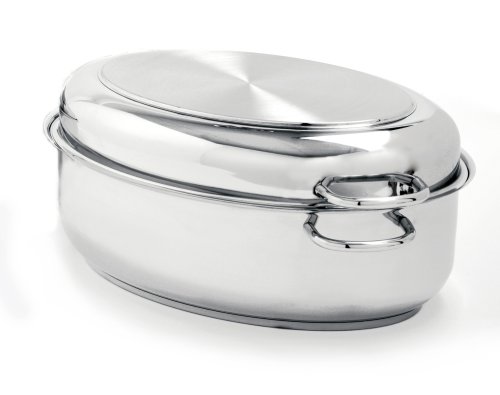
Norpro’s Krona Stainless Steel Roasting Pan with Encapsulated Base, available on Amazon
This combination delivers superb conductivity and heat distribution from the disk layer of aluminum or copper, plus the lightweight durability, ease of cleaning, and sleek appearance of stainless steel.
Norpro’s Krona 17.75-inch roaster offers quality materials and construction with a thick, encapsulated base and a heavy-duty rack. It’s available on Amazon.
Plus, the flat-topped lid doubles as a second pan with a slightly thinner encapsulated base.
Glassware
Glassware baking and roasting pans such as those from Pyrex and CorningWare are not safe for the stovetop and should never be placed on a hot burner – which limits its ability to go from the oven to the hob.
Also, glassware is quite heavy, and prone to chipping, cracks, and breakage with use. It shouldn’t be used in ovens over 425°F.
Nonstick and Teflon
Nonstick cookware that feature coatings like ceramic, silicone polyester, and Teflon are excellent at preventing sticking, but they can also be high maintenance and of a delicate nature.
Cuisinart Nonstick Roaster, available at Wayfair
Even when handled with care, traditional nonstick coatings are prone to chipping, peeling, and scratching, and they’re definitely not broiler safe – temperatures over 500°F can destroy the coating.
Also, roasting produces delicious caramelized coatings and drippings for deglazing into sauces and gravies – but the very nature of nonstick coatings prevents the juices from binding and developing deep flavors and rich colors.
And similar to anodized aluminum, the dark coloring of most nonstick surfaces makes it difficult to see what’s happening on the bottom.
Ceramic nonstick coatings offer superior durability to those of silicone polyester but are also apt to chip and crack with use.
This 17-inch nonstick roaster from Cuisinart is available at Wayfair and features upright, wide-grip handles and includes a sturdy rack.
Stainless Steel
Stainless steel has many advantages and makes a popular choice.
Cooks Standard Stainless Steel Roasting Pan with Stainless Steel Rack, available on Wayfair
Tough and durable under high heat, stainless steel is relatively lightweight, cleans up easily, and has an attractive brushed or polished appearance.
However, stainless steel (304) has a low thermal conductivity value of only 25, and on its own, heat distribution can be spotty. Hot spots can result in scorching or burning, particularly over direct heat.
The 16-inch Cooks Standard roaster is made of high-grade, 18/10 stainless steel with a warp-resistant base and comes with a stainless steel rack, but it is not suitable for use on induction ranges. It’s available on Wayfair.
Features to Look For
When selecting pans, use the following points to help find the perfect roaster for your needs.
Handles
Without a secure purchase, a fully laden, hot, and heavy roaster can be dangerous.
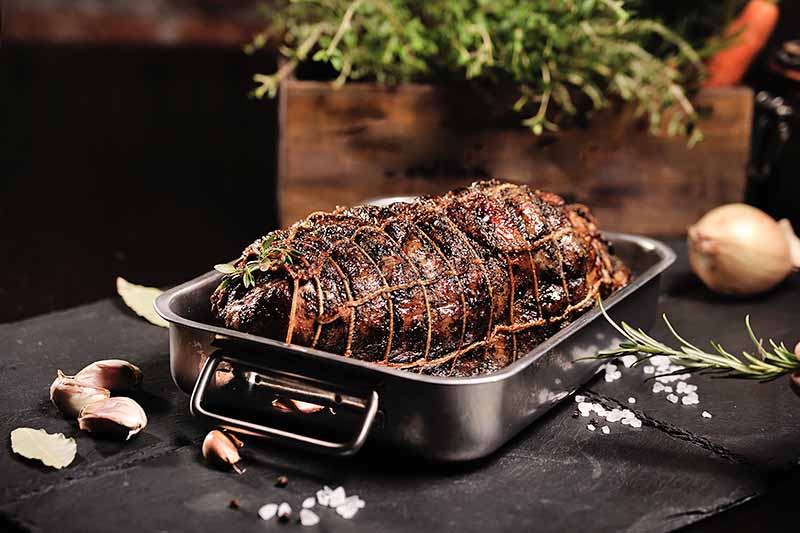
For stability and ease of use, look for large loop handles that are firmly fixed in place with sturdy rivets or welds, and wide enough to accommodate a comfortable grasp with thick mitts.
On pans with helper handles molded into the sidewall construction, ensure they’re large enough to hold safely with mitts.
Bale handles – rectangular wire handles that slide up and down in a guide – are convenient for saving storage space but tend to be on the flimsy side and can be unstable when manipulating a heavy load.
Oven Size
Interior oven measurements can vary greatly, particularly with apartment or space-saver models. And you want to ensure that lovely, new roaster you have your eye on will actually fit – before purchasing it!
Take a few minutes to measure your oven and compare the dimensions to the pan you’re looking at – and remember to include the length of the handles when measuring.
Pan Size
When deciding what size to purchase, a few points should be considered:
Pans need to have the capacity to accommodate large items without touching the sides, and enough space to allow adequate air circulation for thorough roasting and browning.
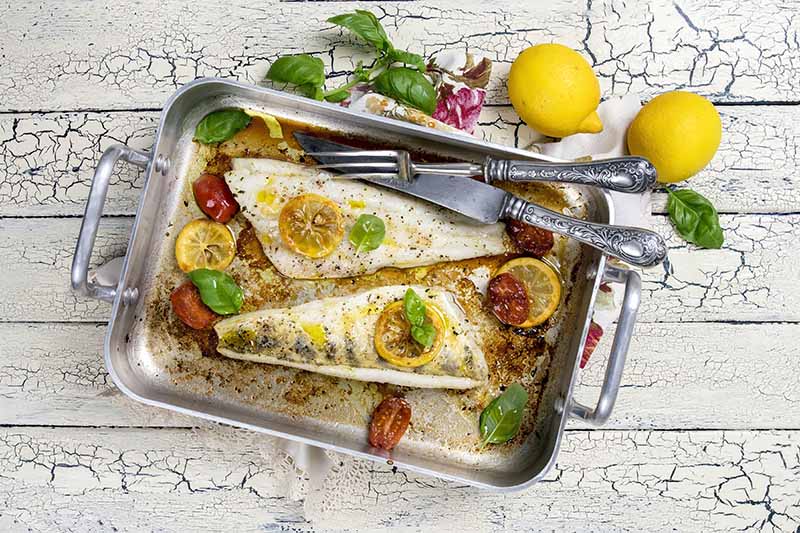
However, when a pan is oversized, too much of the bottom is exposed, which can burn the precious juices released in cooking.
If you have the space to store multiple sizes, great. If not, an easy solution for smaller cuts is to add some chunky veggies and herbs on the bottom to prevent the drippings from burning.
It should also be noted that some pan size measurements include the handles and others don’t, so be sure to check the inside measurements for accurate capacity.
Here’s a general rule of thumb for size requirements:
- A small roaster measures approximately 2 x 14 x 10 inches (D, L, W) and is good for turkeys up to 12 pounds (serves 4-5 people).
- A medium-sized pan measures 3 x 14-16 x 12 inches and comfortably accommodates turkeys up to 16 pounds (6-10 people).
- A large pan has dimensions of 4 x 16-18 x 13 inches and works for turkeys up to 25 pounds (10-20 people).
Sidewall depth is another important factor.
Walls that are too low run the risk of splashing hot fats and liquids. And walls that are too high make it awkward to handle large cuts, plus they encourage hot air to rise up, with the potential for undercooked meat on the bottom.
Look for the Goldilocks depth of 3-5 inches for efficient roasting.
Racks
Some roasters come with racks, and some without.
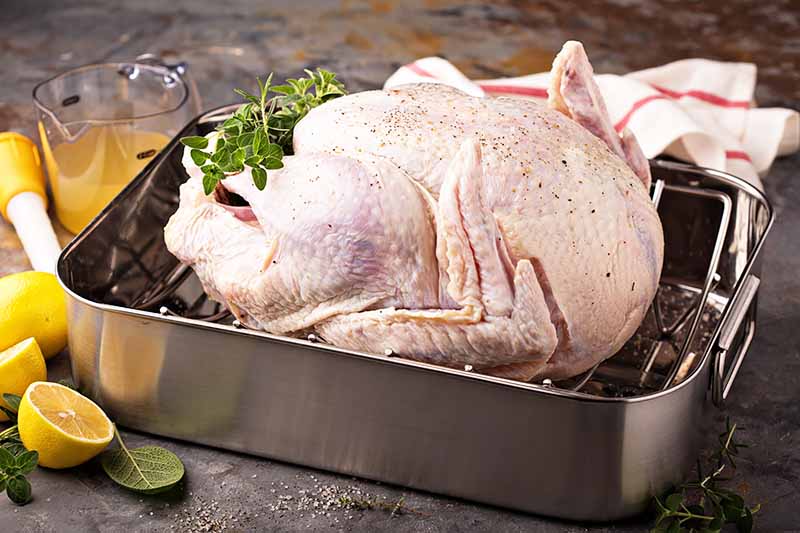
A rack is needed to raise large pieces of proteins off the bottom to allow air circulation for even roasting.
Without a rack, proteins often steam or simmer in their own juices. This results in soft, saggy skin on poultry, and inadequate browning on the bottom of roasts.
Racks also permit the fats and juices to properly drip onto the pan bottom – and these reduced juices, the drippings, are needed for making delicious gravies and sauces.
A rack will also collect a lot of those valuable drippings, and foods tend to stick to them as well, making them challenging to clean. This is where a nonstick coating is useful.
Along with a nonstick surface, look for racks with sturdy handles for safe, easy lifting that also provide for adequate air circulation on the bottom.
Shape
Roasters come in two basic shapes – oval and rectangular.
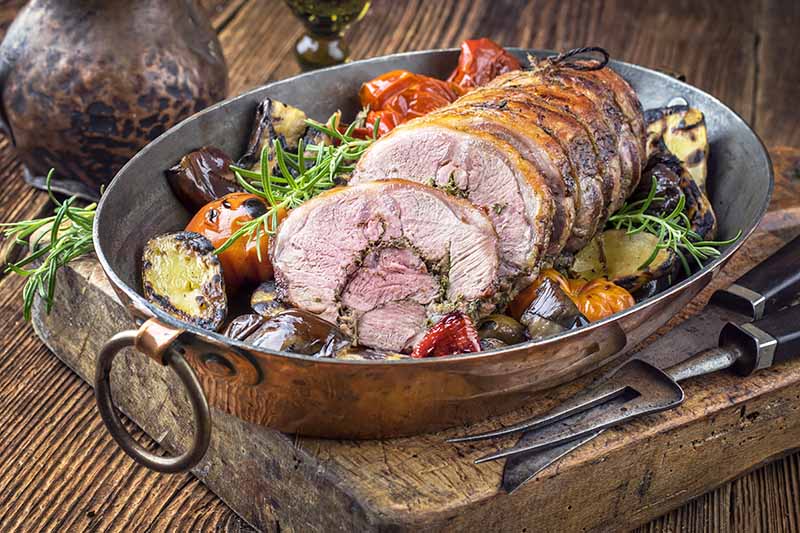
Oval roasters have sleek lines and, not surprisingly, work well with oval-shaped roasts such as chicken, turkey, ham, prime rib, and so on. They also make for easy whisking as there are no corners to block the whisk.
However, because they’re smaller than rectangles in terms of total surface area, they have their limitations when cooking multiple items such as chickens or game hens.
Rectangular pans offer a bit more versatility when cooking more than one item, because of the extra area the right angles provide. But tight corners can be awkward for sauce making, and difficult to clean.
For the best of both worlds, look for a rectangular pan with rounded corners.
Stovetop Performance
For maximum efficiency, a good roaster should be able to easily transfer from the oven to the stovetop to transform the delicious, browned drippings into full-flavored gravies, reductions, and sauces.
This makes flat-bottomed pieces ideal for stovetop work. Pans engineered for strength with dimples, ridges, or troughs on the bottom can make deglazing or whisking a challenge.
Most construction materials work well on electric and gas ranges, with the exception of glassware, which should not be used on the stovetop. Also, heavy cast iron needs to be moved with care on glass stovetops to prevent scratching.
Induction ranges require a magnetic metal for electric resistance heating. Clad or multi-ply, carbon steel, enameled carbon steel, cast iron, enameled cast iron, and magnetic stainless steel are all good options for induction stovetops.
Weight
The weight of your pan is important because it needs to be able to handle high heat without warping or twisting.
Solid construction is also needed for even heat distribution, which helps to prevent burning of the treasured drippings that form the flavorful base of reductions, sauces, and gravies.
The heft of your roaster should feel solid when handling it, but not so heavy as to make it cumbersome when lifting – you want to be able to handle it easily when it’s hot from the oven and loaded with goodies.
Versatile Cookware
Roasting pans aren’t just for the Thanksgiving turkey and big cuts of meat.
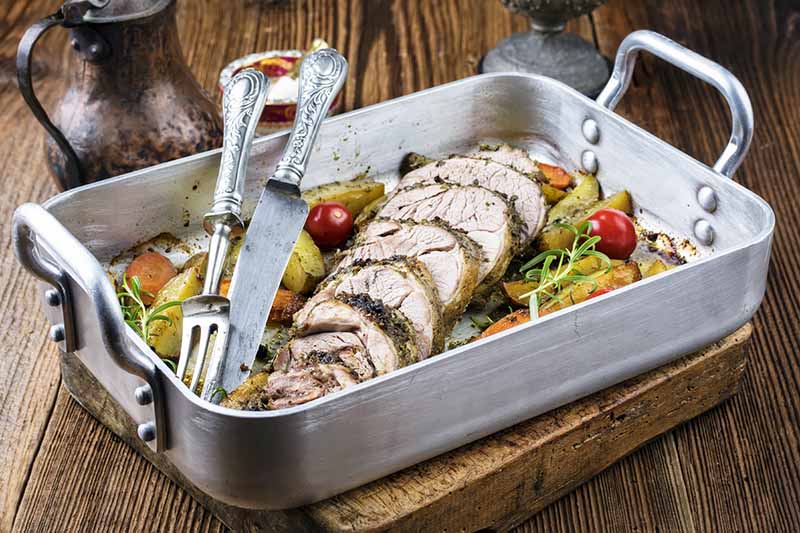
These versatile pieces of cookware are perfect year-round and ideal for fast weeknight meals like one-pan dinners, a large batch of lasagna, an assortment of roasted vegetables, and stews.
For the best value, determine how often you’ll use a roaster, then look for the features and materials that suit your needs, such as oven to stovetop performance, searing, or fast and easy cleanup.
If you’ll only use it once a year, a budget model works fine. But for frequent use, go for the best quality you can afford to ensure top-notch results.
And for more cookware know-how, check out these guides next.
- Types of Cookware: What Is Best For Me?
- Choosing Between Copper and Cast Iron Cookware
- Cast Iron Cookware: What You Need to Know
© Ask the Experts, LLC. ALL RIGHTS RESERVED. See our TOS for more details. Product photos via Amazon, Wayfair, Zwilling, Le Creuset, and Made-In. Uncredited photos via Shutterstock. Originally published on February 8, 2020. Last updated on November 18, 2022.
About Lorna Kring
Recently retired as a costume specialist in the TV and film industry, Lorna now enjoys blogging on contemporary lifestyle themes. A bit daft about the garden, she’s particularly obsessed with organic tomatoes and herbs, and delights in breaking bread with family and friends.

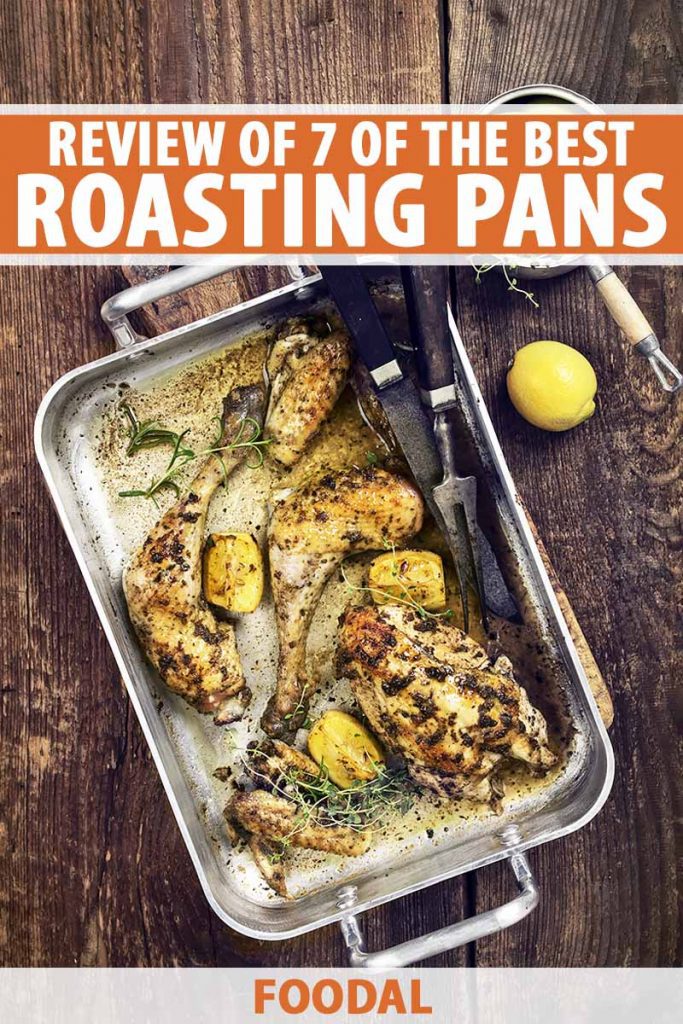
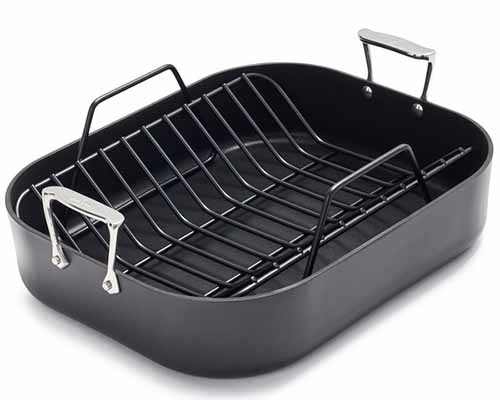
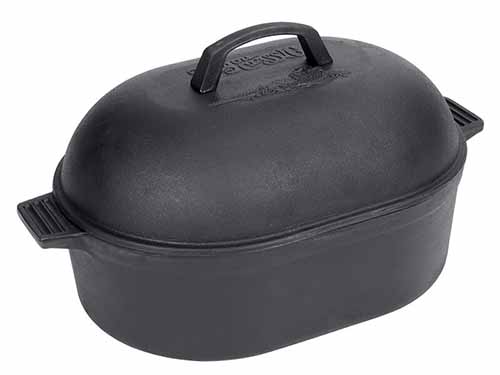
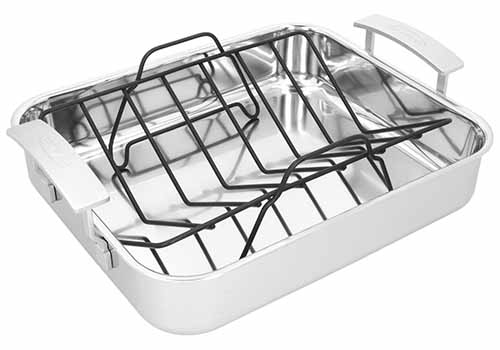
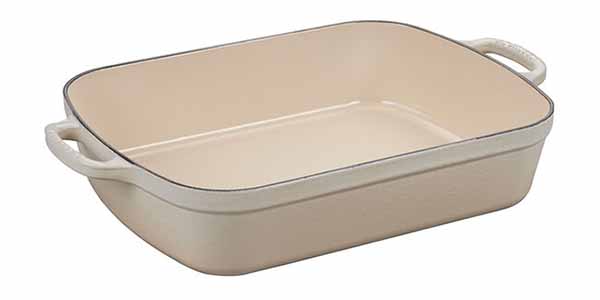
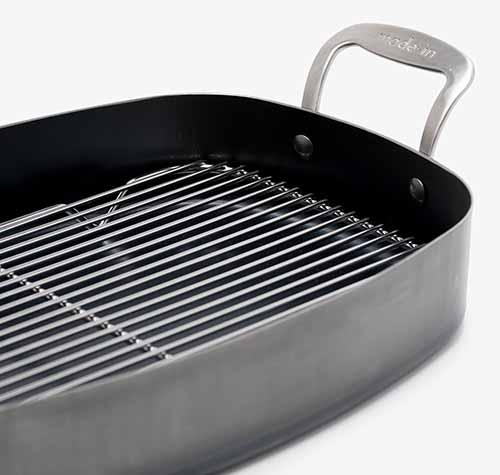

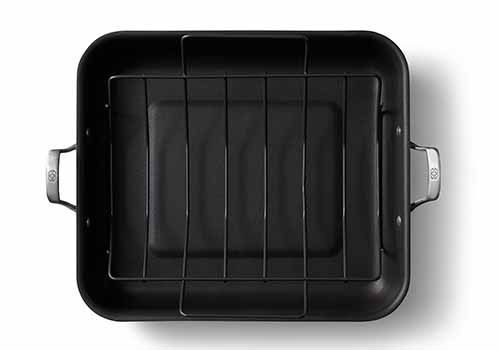
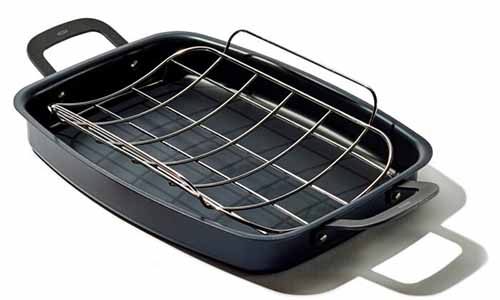
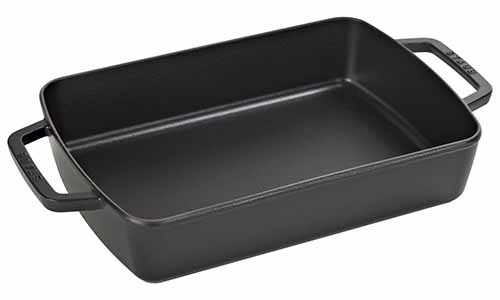
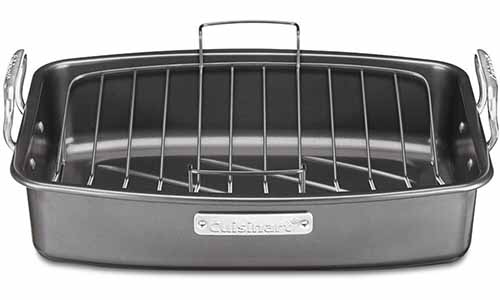
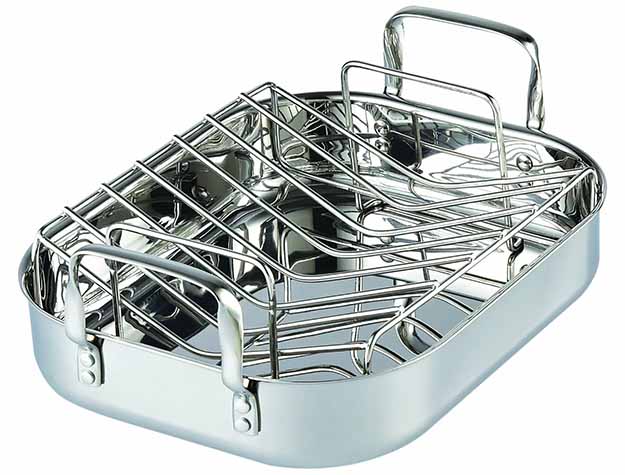


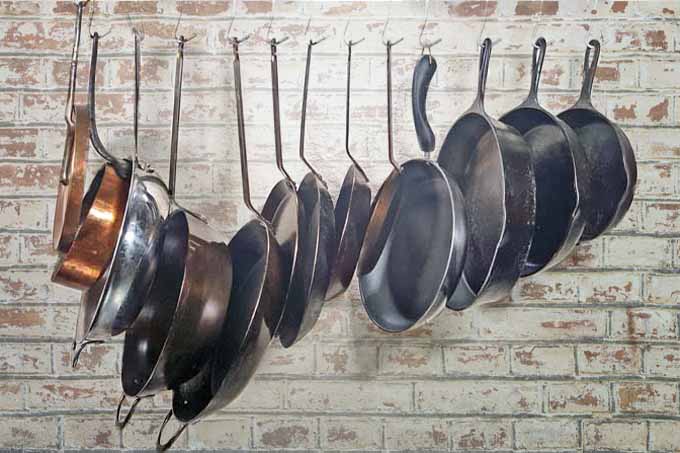
Thanks for this information. I have been having a lot of problems with my pans and they are very ugly. I’ve even considered not using them to serve things buffet style whenever I have visitors. Now i know the little secrets in selecting the best.
Glad you found the post helpful ellyjude, a good product can make a big difference in the results we get.
Thanks for this thorough post! I appreciate the effort – it must have taken a lot of time to test all those.
I like that you have shown items in different price ranges. That way there’s something for everyone.
I love making informed choices, and now I know what to look for when buying a roaster.
Knowledge is power Elfprincess… hope you find one to suit your needs.
It is nice to see that some roasters will come with a rack. We have had our little pan for so long I don’t even know what it is made out of. It is just big enough for a small ham. When we want to cook our turkey we simply just buy the cheap aluminum versions from the dollar store. Then once we are done we throw it away. Although that just means one less dish for me to clean I haven’t thought about whether or not the aluminum will get into our turkey.
Disposable pans certainly have their place Jasmine, but over time it’s probably more economical to purchase one your can keep! The down side is, you will have to wash it…
I do not think you really have to worry about the aluminum seeping into the meat or anything, at least I really hope not. I am a big fan of the disposable pans too, but Lorna is right in that in the long run, you might as well spend a little money and a good one that can last you for a long time. Glad to see a nice review of everything to consider here, though, and that certainly always helps.
I love the content here at Foodal. Never ceases to entertain and inform me! So glad I found you guys. Thanks for providing great info for us–we need it!
So glad you enjoy the content jessemspringer, relevance rocks!
I’m not a serious cook yet. Thus, normally I would choose price over anything else. But reading through the whole article, WOW – there’s so much to consider and they all make sense. Price isn’t everything. I appreciate all the information presented here. I would have thought that enameled cast iron are pretty and worth considering, but the heads up about it being prone to chipping or cracking sure gives me pause now. Anyway, thank you for the VERY informative and THOROUGH guide. I’m sure a lot of beginner cooks will appreciate the valuable input.
Glad you found the post to be informative saravet. There’s a lot to choose from and price alone can often be misleading.
I have selected some of the best pans for my kitchen thanks to the tips in this article. I am now looking forward to some more articles regarding kitchen tools. I am planning to put up a master kitchen before i get married on April this year.
Elly, we have a bunch of tool guides on Foodal. Hit the search bar on the upper right (yeah I know it’s small – we’re going to adjust it in the near future) with “tools” and “utensils” and you’ll find more guides than you probably want to read.
🙂 Sure wish I would have seen this last week! The culprit was a MONSTER ham we were given for Christmas. I had it frozen and decided to finally make it. Well the first issue was not having a pan large enough for it.
I didn’t really want to run out and find one so soon to when it had to go into the oven (my, those things take long!) so I just “made it fit” into a glass casserole I had… biggest thing I could find.
It worked okay, I guess… ham tasted fine and everything, but for issue #2, all that water that cooked out of it nearly overflowed the top of my pan. What a mess I would have had! Shivers! 🙁
Next time (if there is one… I’m hoping not! hehe) I use a proper roaster and this article is a keeper for that very reason.
The ‘just make it fit’ scenario can be nerve-wracking Kate, glad it worked out for you! But don’t forget about next time…
This is one of the best product reviews I believe I have ever read. It’s thorough and answers every question about these products I could have wanted to ask. Thank you!!
I have an oven a hair under 17 inches wide so I was really interested in the Viking handles to save on width.
But it turns out at least on amazon that the specs for that are incorrect. It’s actually 17.5 inches wide if you include the handles.
Going to have to return it and keep looking.
Viking pan is very sturdy and induction capable for making pan gravy afterward. After some research and looking at positive reviews this is the best for my brisket.
My husband insisted that all those pans are too expensive (even though I adamantly disagreed with him) and he ended up buying TeamFar Roasting Pan, 15 Inch with V Rack & Cooling Rack Set Stainless Steel for $40. We use our Weber kettle grill most of the time for cooking chickens and turkeys. We did have a super terrible mainstays nonstick roaster with rack for $20 that went to complete junk after a short 3 years (I now use the rack as a vertical baking sheet holder hahah). The ONLY reason why I gave this TeamFar a chance is because it looked a lot like the Viking and the Caphalon with the large handles. I will give it a few rounds and I will update this post to let you guys know. I’m hopeful but not very optimistic.
Not sure when this article was written, but your budget buy “CALPHALON CONTEMPORARY 16-INCH ROASTER” actually costs more then the best pick “VIKING LARGE ROASTING PAN” on Amazon
Wish you would give a simple chart of the size roasting pan needed for different sizes of beef roasts and poultry. After an easy guide chart, the extra information would be helpful.
It is not fun to have paragraph after paragraph to read and not have the basic sought information given.
Great, suggestion, Nan. We’re working on an update for this article, and this might be something we can add in the future.
Hey Nan, there’s a outline of the three pan sizes and the quantities they hold in the Size section above – it’s basic but should have the info you want.